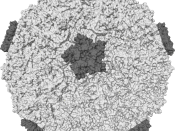A. Etiology
Acute viral rhinitis is one of the infectious disorders in the upper respiratory tract.
It is also called coryza or the common cold and is considered as the leading cause of doctor's visits and missed days from school and work. According to the Centers for Disease Control and Prevention, about 22 million school days are missed yearly here in the U.S. mainly due to acute viral rhinitis.
Rhinitis is the inflammation of the nasal mucous membranes. It is caused by viruses that attack the upper respiratory tract, including the nasal cavity ,sinuses, pharynx and larynx. There are more than 200 different viruses known to cause the common cold, however the rhinovirus is the most common pathogen. The common cold is spread through airborne droplets. This means that the virus enters the body through the nose or mouth especially when the infected person sneezes, coughs, or makes direct hand contact with another person.
Using contaminated objects, such as utensils, towels, toys, or telephones or touching contaminated surfaces, such as doorknobs, tray tables, water pitchers and then later touching your eyes, nose or mouth after such contact or exposure is the easiest way of spreading this virus.
B. RISK FACTORS
Who are at risk? Children are more at risks to the common cold because they still have an immature immune system and haven't yet developed resistance to most pathogen-causing diseases. Children have about 6 - 10 colds per year. This is primarily due to exposure to the virus in daycare centers and schools by means of direct contact. They tend to spend lots of time with other children and aren't always careful about washing their hands. Adults are also at risk especially when they spend most of the time indoors and in close contact with other people; have an...


